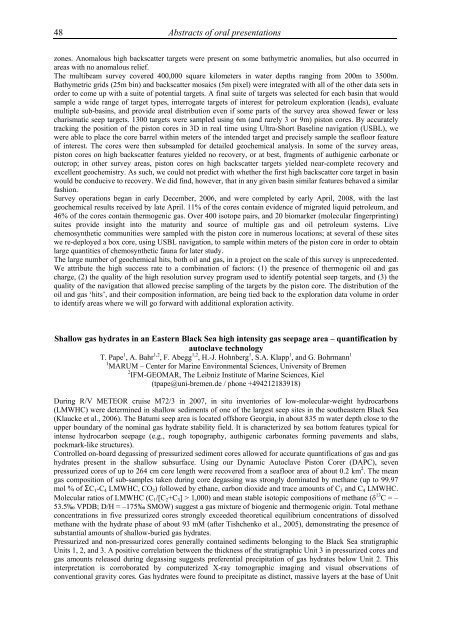Ninth international conference on - Marum
Ninth international conference on - Marum
Ninth international conference on - Marum
Create successful ePaper yourself
Turn your PDF publications into a flip-book with our unique Google optimized e-Paper software.
48<br />
Abstracts of oral presentati<strong>on</strong>s<br />
z<strong>on</strong>es. Anomalous high backscatter targets were present <strong>on</strong> some bathymetric anomalies, but also occurred in<br />
areas with no anomalous relief.<br />
The multibeam survey covered 400,000 square kilometers in water depths ranging from 200m to 3500m.<br />
Bathymetric grids (25m bin) and backscatter mosaics (5m pixel) were integrated with all of the other data sets in<br />
order to come up with a suite of potential targets. A final suite of targets was selected for each basin that would<br />
sample a wide range of target types, interrogate targets of interest for petroleum explorati<strong>on</strong> (leads), evaluate<br />
multiple sub-basins, and provide areal distributi<strong>on</strong> even if some parts of the survey area showed fewer or less<br />
charismatic seep targets. 1300 targets were sampled using 6m (and rarely 3 or 9m) pist<strong>on</strong> cores. By accurately<br />
tracking the positi<strong>on</strong> of the pist<strong>on</strong> cores in 3D in real time using Ultra-Short Baseline navigati<strong>on</strong> (USBL), we<br />
were able to place the core barrel within meters of the intended target and precisely sample the seafloor feature<br />
of interest. The cores were then subsampled for detailed geochemical analysis. In some of the survey areas,<br />
pist<strong>on</strong> cores <strong>on</strong> high backscatter features yielded no recovery, or at best, fragments of authigenic carb<strong>on</strong>ate or<br />
outcrop; in other survey areas, pist<strong>on</strong> cores <strong>on</strong> high backscatter targets yielded near-complete recovery and<br />
excellent geochemistry. As such, we could not predict with whether the first high backscatter core target in basin<br />
would be c<strong>on</strong>ducive to recovery. We did find, however, that in any given basin similar features behaved a similar<br />
fashi<strong>on</strong>.<br />
Survey operati<strong>on</strong>s began in early December, 2006, and were completed by early April, 2008, with the last<br />
geochemical results received by late April. 11% of the cores c<strong>on</strong>tain evidence of migrated liquid petroleum, and<br />
46% of the cores c<strong>on</strong>tain thermogenic gas. Over 400 isotope pairs, and 20 biomarker (molecular fingerprinting)<br />
suites provide insight into the maturity and source of multiple gas and oil petroleum systems. Live<br />
chemosynthetic communities were sampled with the pist<strong>on</strong> core in numerous locati<strong>on</strong>s; at several of these sites<br />
we re-deployed a box core, using USBL navigati<strong>on</strong>, to sample within meters of the pist<strong>on</strong> core in order to obtain<br />
large quantities of chemosynthetic fauna for later study.<br />
The large number of geochemical hits, both oil and gas, in a project <strong>on</strong> the scale of this survey is unprecedented.<br />
We attribute the high success rate to a combinati<strong>on</strong> of factors: (1) the presence of thermogenic oil and gas<br />
charge, (2) the quality of the high resoluti<strong>on</strong> survey program used to identify potential seep targets, and (3) the<br />
quality of the navigati<strong>on</strong> that allowed precise sampling of the targets by the pist<strong>on</strong> core. The distributi<strong>on</strong> of the<br />
oil and gas ‘hits’, and their compositi<strong>on</strong> informati<strong>on</strong>, are being tied back to the explorati<strong>on</strong> data volume in order<br />
to identify areas where we will go forward with additi<strong>on</strong>al explorati<strong>on</strong> activity.<br />
Shallow gas hydrates in an Eastern Black Sea high intensity gas seepage area – quantificati<strong>on</strong> by<br />
autoclave technology<br />
T. Pape 1 , A. Bahr 1,2 , F. Abegg 1,2 , H.-J. Hohnberg 1 , S.A. Klapp 1 , and G. Bohrmann 1<br />
1 MARUM – Center for Marine Envir<strong>on</strong>mental Sciences, University of Bremen<br />
2 IFM-GEOMAR, The Leibniz Institute of Marine Sciences, Kiel<br />
(tpape@uni-bremen.de / ph<strong>on</strong>e +494212183918)<br />
During R/V METEOR cruise M72/3 in 2007, in situ inventories of low-molecular-weight hydrocarb<strong>on</strong>s<br />
(LMWHC) were determined in shallow sediments of <strong>on</strong>e of the largest seep sites in the southeastern Black Sea<br />
(Klaucke et al., 2006). The Batumi seep area is located offshore Georgia, in about 835 m water depth close to the<br />
upper boundary of the nominal gas hydrate stability field. It is characterized by sea bottom features typical for<br />
intense hydrocarb<strong>on</strong> seepage (e.g., rough topography, authigenic carb<strong>on</strong>ates forming pavements and slabs,<br />
pockmark-like structures).<br />
C<strong>on</strong>trolled <strong>on</strong>-board degassing of pressurized sediment cores allowed for accurate quantificati<strong>on</strong>s of gas and gas<br />
hydrates present in the shallow subsurface. Using our Dynamic Autoclave Pist<strong>on</strong> Corer (DAPC), seven<br />
pressurized cores of up to 264 cm core length were recovered from a seafloor area of about 0.2 km 2 . The mean<br />
gas compositi<strong>on</strong> of sub-samples taken during core degassing was str<strong>on</strong>gly dominated by methane (up to 99.97<br />
mol % of ΣC1-C4 LMWHC, CO2) followed by ethane, carb<strong>on</strong> dioxide and trace amounts of C3 and C4 LMWHC.<br />
Molecular ratios of LMWHC (C1/[C2+C3] > 1,000) and mean stable isotopic compositi<strong>on</strong>s of methane (δ 13 C = –<br />
53.5‰ VPDB; D/H = –175‰ SMOW) suggest a gas mixture of biogenic and thermogenic origin. Total methane<br />
c<strong>on</strong>centrati<strong>on</strong>s in five pressurized cores str<strong>on</strong>gly exceeded theoretical equilibrium c<strong>on</strong>centrati<strong>on</strong>s of dissolved<br />
methane with the hydrate phase of about 93 mM (after Tishchenko et al., 2005), dem<strong>on</strong>strating the presence of<br />
substantial amounts of shallow-buried gas hydrates.<br />
Pressurized and n<strong>on</strong>-pressurized cores generally c<strong>on</strong>tained sediments bel<strong>on</strong>ging to the Black Sea stratigraphic<br />
Units 1, 2, and 3. A positive correlati<strong>on</strong> between the thickness of the stratigraphic Unit 3 in pressurized cores and<br />
gas amounts released during degassing suggests preferential precipitati<strong>on</strong> of gas hydrates below Unit 2. This<br />
interpretati<strong>on</strong> is corroborated by computerized X-ray tomographic imaging and visual observati<strong>on</strong>s of<br />
c<strong>on</strong>venti<strong>on</strong>al gravity cores. Gas hydrates were found to precipitate as distinct, massive layers at the base of Unit














